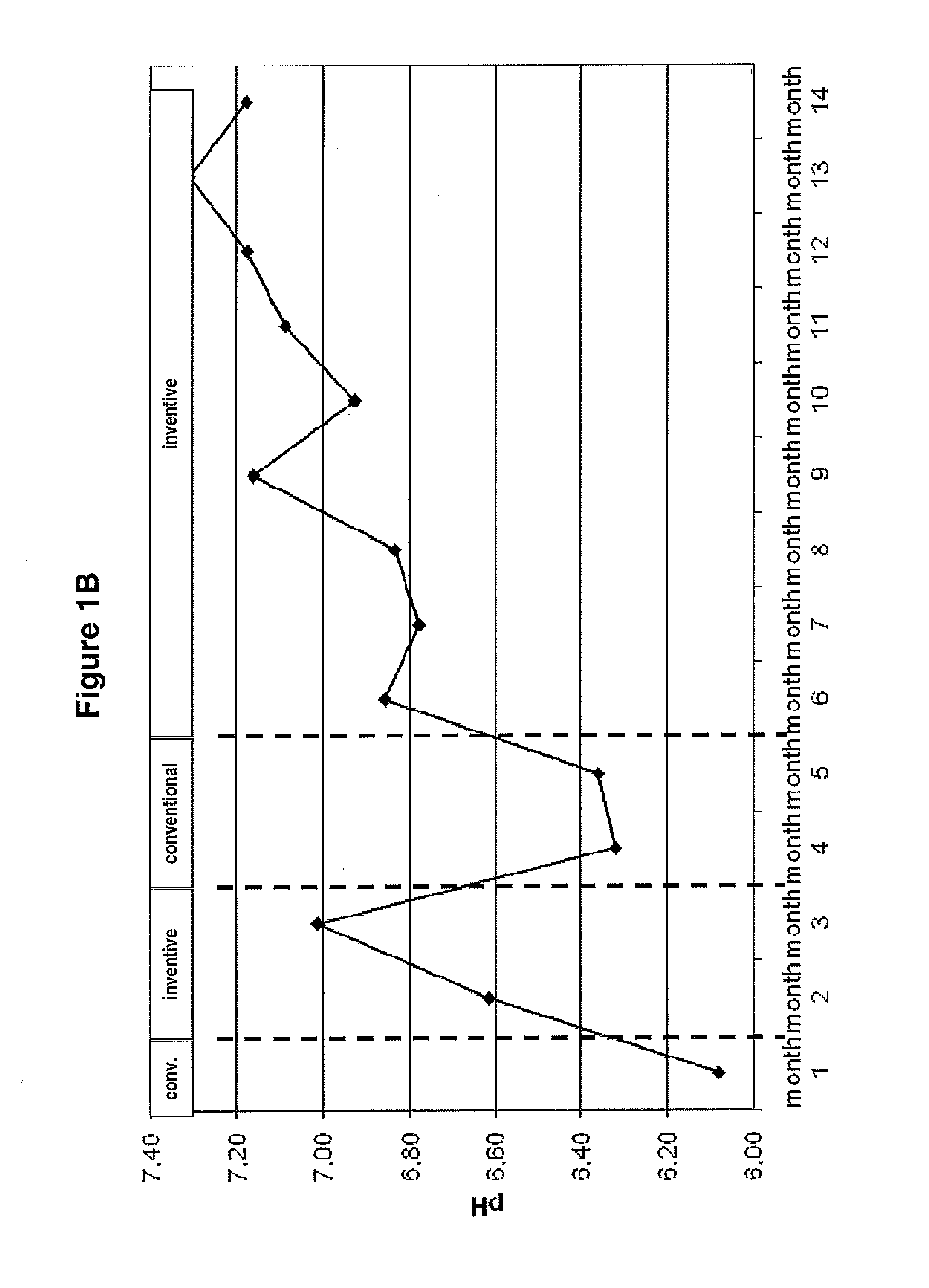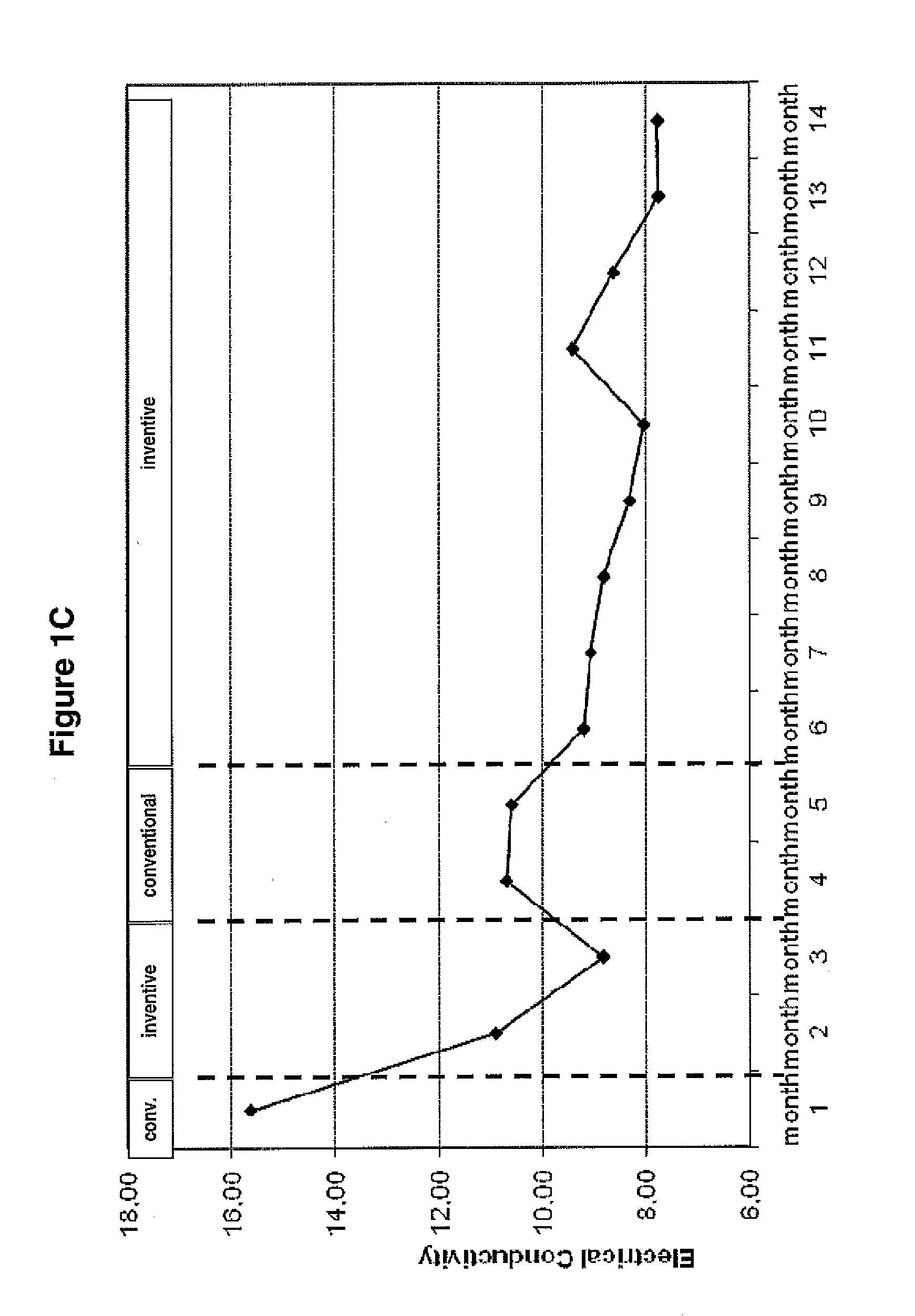Method for increasing the advantages of strength aids in the production of paper and paperboard
a technology of strength aids and paper, which is applied in the field of manufacturing paper, paperboard or cardboard, can solve the problems of reducing the effectiveness of glyoxylated polymers, reducing the efficiency of glyoxylated polymers, and not providing significant wet strength, so as to reduce the electrical conductivity of the aqueous phase, prevent microbiological degradation of starch, and reduce the effect of electrical conductivity
- Summary
- Abstract
- Description
- Claims
- Application Information
AI Technical Summary
Benefits of technology
Problems solved by technology
Method used
Image
Examples
example 1
[0341]The following experiments were run on different commercially used paper mills throughout Europe. Examples 1 and 4 were run on a closed system, whereas the other Examples were run on open systems. The starting material was in each case 100% recycled papers. The following biocides were employed at the following dosages and feeding points as summarized in Table 5:
TABLE 5Parameters for settingsA, B, C and DSetting ASetting BSettingt CSetting Dfurnish types [CEPI]1.021.021.021.021.041.041.041.044.014.011.01NH4Br biocidedosage [concentration0.0200.0190.0190.017of active substanceequivalent to elementalchlorine, expressed in% active substance asCl2 per ton producedpaper]feeding pointspulper dilutionpulper dilutionpulper dilutionpulper dilutionwater, whitewater, whitewater, whitewater, whitewater 2, whitewater 1, clearwater 1, clearwater 2, whitewater 1,filtrate, inletfiltrate, inletwater 1,clarifiedclarificationclarificationclarifiedshower watershower waterorganic biocidedosage [g / to...
example 2
[0346]Another experiment was conducted at a paper mill that had been employing conventional, low amounts of biocide (NH4Br / NaOCl, <400 g / t). When increasing the feed rate of this biocide and adding organic, non-oxidizing biocide as a further biocide, it could be shown in one day only that the conductivity of the system can be substantially decreased.
[0347]FIG. 2 shows that the increase of biocide dosage immediately resulted in a substantial decrease of electrical conductivity from about 2000 μS / cm to about 1500 μS / cm within only 1 day. The dotted vertical line to the left indicates when the biocide dosage according to the invention was started, i.e. when the conventional addition of NH4Br biocide was changed to biocide addition in accordance with the invention, and the dotted vertical line to the right indicates when the biocide dosage according to the invention was terminated, i.e. when the conventional addition of NH4Br biocide was resumed. At the time interval inbetween the two d...
example 3
[0348]36 experiments that were conducted at 19 paper mills were analysed with respect to the performance of dry and / or wet strength polymers in dependence of the electrical conductivity. The dry and / or wet strength polymers that were employed in the experiments were two different glyoxylated polyacrylamide products (GPAM), and the dosage of GPAM varied between 1.5 and 4 kg / t db vs. the cellulosic material with an average of 2.8 kg / t db.
[0349]The results are summarized in FIG. 3. The trend line has a R2 value Of 0.72 (standard deviation).
[0350]FIG. 3 shows the dependency of performance of dry and / or wet strength polymers depending upon the electrical conductivity of the aqueous phase of the cellulosic material. The performance of the dry and / or wet strength polymer is expressed in terms of an efficiency ratio that takes into account the increase of CMT (result of the concora medium test), burst strength, tensile strength and dosage of dry and / or wet strength polymer. The efficiency w...
PUM
| Property | Measurement | Unit |
|---|---|---|
| Fraction | aaaaa | aaaaa |
| Fraction | aaaaa | aaaaa |
| Time | aaaaa | aaaaa |
Abstract
Description
Claims
Application Information
 Login to View More
Login to View More - R&D
- Intellectual Property
- Life Sciences
- Materials
- Tech Scout
- Unparalleled Data Quality
- Higher Quality Content
- 60% Fewer Hallucinations
Browse by: Latest US Patents, China's latest patents, Technical Efficacy Thesaurus, Application Domain, Technology Topic, Popular Technical Reports.
© 2025 PatSnap. All rights reserved.Legal|Privacy policy|Modern Slavery Act Transparency Statement|Sitemap|About US| Contact US: help@patsnap.com



